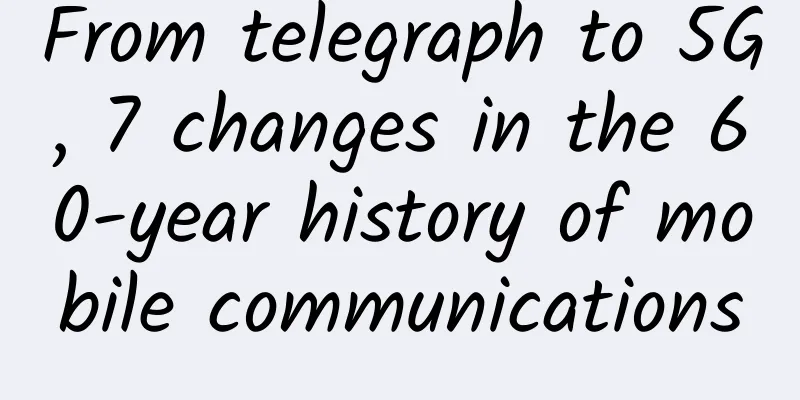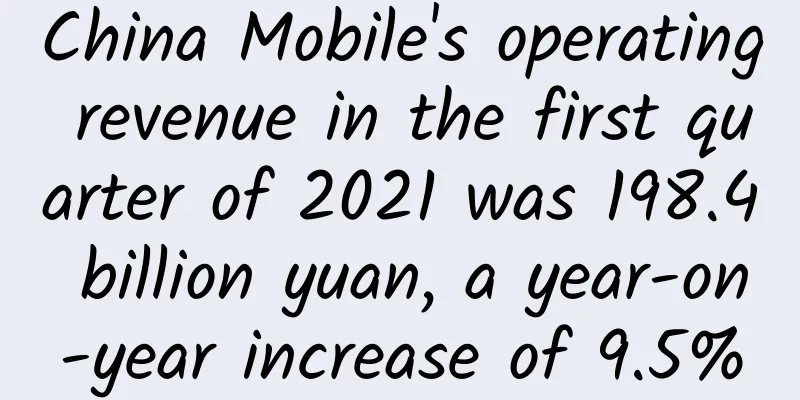From telegraph to 5G, 7 changes in the 60-year history of mobile communications

|
The history of communication has been around for more than 60 years, and it has gone through seven eras of change from the development of telegraph to 5G. Did you know that Bell, the "inventor" of the telephone, was a thief? Did you know that Motorola had already risen in the 0G era? Do you know which place in my country first opened a mobile communication network? In which era did Qualcomm rise? Did Apple understand the application economy very early? Today, we will not only introduce 5G, but also introduce to you what interesting things happened in the seven eras of the history of communication over the past 60 years. From telegraph to 5G: 7 secrets of 60 years of mobile communications history 01 Is Bell, the “inventor” of the telephone, actually a thief? Keywords: Bell, AT&T, Bell Labs As early as 1871, Italian Antonio Meucci began to apply for a patent for his Teletrofono telephone system. He spent $10 to buy the patent rights that needed to be renewed every year. Three years later, he was unable to pay, and the scandal of Bell being the inventor of the telephone began. Bell did not invent the telephone In fact, Bell and Antonio Meucci once worked in a studio. Later, because Antonio Meucci was unable to pay the patent fee, Bell and Gray took all the technical documents about the telephone to the US Patent Office to apply for a lifetime patent without Antonio Meucci's knowledge. Bell then acquired some of Gray's content through commercial operations, acquired Edison's technology, and became the owner of telephone technology. Bell has always claimed that he was the inventor of the telephone until 2002, when the US House of Representatives officially returned the invention of the telephone to Antonio Meucci. AT&T is still a communications giant Although it was a major scandal in the history of communications, Bell, the "thief and liar", actually laid a solid foundation for the development of the communications industry, such as the establishment of the Bell Telephone Company. As the first public telephone service company, the Bell Telephone Company promoted telephones to the general public. The world-renowned communications giant AT&T was separated from the Bell Company. After so many antitrust splits, AT&T is still a giant. You can imagine the influence of the Bell Telephone Company back then. The "videophone" made by Bell Labs in 1964 Bell Labs was established after AT&T acquired a research department of Western Electronics. Many early communication technologies were developed based on the research results of Bell Labs. It can be said that Bell, Bell Telephone Company and Bell Labs played a vital role in the foundation and development of mobile communications. By the way, the current Bell Labs has become a small research institute, researching 5G-related technologies, etc., and has long lost its former glory. 02 0G era: The success of Motorola Keywords: Car mobile phone, Motorola Before 1G, there was actually an era called 0G, or the 0th generation of mobile communications. In the 1950s, mobile communications technology already existed, but it did not become an operational business. Instead, it was a wireless extension of fixed-line phones. Users still used fixed-line phone numbers, and operators also provided fixed-line network services, but wireless connection capabilities were a value-added service. Car Mobile Phone Did you know that the demand for wireless connectivity actually came from cars? The American automobile industry developed very early and quickly, and many families owned cars in the early days. Everyone wanted to be able to make calls in the car just like at home. So Motorola came on the scene. Motorola car radio Did you know that Motorola actually started out as a car radio? In the process of manufacturing car semiconductor radios, Motorola acquired wireless communication technology. When car owners had a large demand for wireless communications, Motorola keenly seized this opportunity and rose to become a leader in the field of car mobile phones. At that time, a frequency band in a car phone could only be used by one person. Thanks to the support of Motorola products, Illinois, the United States, opened the world's largest wireless communication system at the time. This system used 64 frequency bands to cover the entire city. However, this communication system also had its own problems, because its frequency bands were exclusive, that is, only one person could use a frequency band for wireless communication, and others could only choose other frequency bands. Therefore, only 64 people could talk at the same time, and once the antenna coverage was exceeded, the call was forced to be interrupted. However, at that time, being able to realize wireless communication was the greatest happiness for people. Our country had just been established not long ago. 03 1G era: The birth of cellular, Guangdong Province was the first to open Keywords: cellular mobile communications, mobile phones, Guangdong Province In the 1970s and 1980s, we entered the 1G era, the first generation of mobile communications, and our cellular mobile communications system was born. This concept was jointly completed by Motorola and Bell Labs. Cellular brought us into the real mobile communications era. The most powerful product at that time was the mobile phone. If your family had a mobile phone at that time, I would also give you a thumbs up for your wealth. Cellular mobile communications Cellular mobile communication is to divide the communication area covered by an antenna into several communication units, named sectors. Adjacent sectors use different frequencies, and separated sectors can reuse frequencies. The continuous coverage of sectors forms the entire communication network, just like a honeycomb. Under this technology, users can get continuous mobile communication services, because different sectors and mobile terminals can smoothly switch frequencies under the command of the base station controller. And because the frequency can be reused, the number of people who can communicate at the same time increases instantly. However, 1G brings a new problem, which is expensive, because the cost of building base stations is shared by users, resulting in high costs. The consequence of this is that the popularity of 1G is seriously affected. We can't afford to buy a mobile phone, nor can we use it. Now let's move to my country. Guangdong Province was the first region in my country to open a mobile communication network in November 1987. The first batch of users was only 700, and the price of a phone at that time was as high as 20,000 yuan, which was only the public price. The price on the black market had been hyped up to 50,000 yuan. The fee for joining the network was 6,000 yuan, and the call cost 0.6 yuan per minute, which means that the cost of a one-hour local call was as high as 80 yuan. At that time, the monthly income of an ordinary family was not as high as the cost of a one-hour call. In addition, in the 1G era, in addition to the high cost, only call services were available, and there were no text messaging services. 04 2G Era: How did Motorola's Iridium plan fail? Keywords: CDMA, GSM, Motorola's "Iridium Project", Nokia The 1990s ushered in the era of 2G, or second-generation mobile communications. 2G networks not only encrypted calls, but also used the wireless spectrum more efficiently and provided data transmission similar to dial-up Internet or early DSL services. In the 2G era, many technical ideas emerged, such as time division multiple access (TDMA) and code division multiple access (CDMA). The popular GSM at that time was a time division multiple access technology. The 2G era was a competition between these two technologies, but we still have to say that CDMA has more advantages than TDMA, such as large system capacity, high call quality, no frequency interference, and low network construction cost. GSM and CDMA At the same time, in the 2G era, there was also a Motorola "Iridium Project" that tried to find a different way to solve mobile communication problems. What is the Iridium Project? It is to launch 77 satellites into outer space, imitating the 77 extranuclear electrons of the iridium atom. In fact, only 66 satellites are needed. When the earth acts as the nucleus, Iridium can cover the world like a big honeycomb. In this way, communication on the earth can be achieved through two hops of satellites. SpaceX CEO Musk's Iridium plan diagram means the same thing The advantage of this plan is that it can cover any corner of the earth, whether it is a desert, an ocean, or an uninhabited area, communications can be carried out. The total investment of the Iridium plan is 3.4 billion US dollars, which is a huge sum of money both at that time and now. In fact, Motorola received the 3.4 billion US dollars investment in 1998, established Iridium, and 66 satellites have been launched into space. But the plan ultimately failed. Why? The failure of the plan is a problem of the development direction of communication technology. Because every company has its own interests. If you want to establish a global alliance communication network, you need to let many powerful local communication companies give up their own interests, which is something that no one can do. In addition, due to political factors, this kind of global alliance is impossible to continue. In other words, the satellite was launched, but no one supported the plan, so the plan was eventually aborted. However, Iridium is still alive, but its business is bleak and it does some marginalized businesses. Do you remember me? I was the Finnish giant Nokia. Of course, the 2G era was not only about the rise and fall of Motorola, but also about the Finnish mobile phone giant Nokia. Back then, Nokia sold mobile phones at a speed and profit you couldn't imagine. But since the 3G era, Nokia has not kept up with the pace of smart phones and has gradually faded out of everyone's sight. 05 3G era: the birth of Apple iPhone and the rise of Qualcomm Keywords: Apple iPhone, Qualcomm, mobile Internet At the beginning of the 21st century, our generation experienced the mobile phone era, which was the 3G era, or the third generation of mobile communications. In the 3G era, mobile phones officially entered the era of smart phones. At that time, Android and Apple systems began to take off, killing old mobile phone giants such as Nokia, and a group of new brands began to rise rapidly, such as Samsung, Apple, etc. Apple iPhone 3G In the early stage of the transition from 2G to 3G, mobile communications in each country were very different, and there was no consistency in the goal ideas. In 1996, the International Telecommunication Union (ITU) led countries to reach a blueprint for the construction of communication systems, IMT-2000, which is the third generation mobile communication system 3G. The subsequent 4G and 5G also evolved on this basis, 4G is IMT-Advanced, and 5G is IMT-2020. With 3G, the era of mobile Internet and smart phones has begun. We can use WeChat, QQ, and Weibo on our mobile phones. At the same time, a large number of smart phones have begun to compete with each other in the market, and the most famous one is the Apple iPhone. In addition to the iPhone, there are many famous 3G mobile phones. Do you remember the Google Nexus series? Before the launch of the 3G-enabled iPhone, many Nokia phones already supported 3G networks. Meanwhile, the development of 3G in Japan was amazingly fast. Sharp phones at that time became the dream of many people. After the launch of the 3G-enabled iPhone, Google's native Nexus phones were also very famous, and Samsung also rose rapidly in the mobile phone field. At that time, domestic mobile phones were not as strong as they are now, but were suppressed by various foreign giants. The reduction of 3G tariffs has brought a large number of APP applications With the reduction of 3G tariffs, the improvement of bandwidth speed, and the popularization of smart terminals, more and more mobile applications have begun to emerge. The rapid growth of 3G users has provided huge space for all links in the mobile Internet industry chain. New mobile Internet companies and APP companies have also sprung up like mushrooms after rain, and it was also a good time to start a business. Many of our current APP applications started in the 3G era. However, after many reshuffles, the mobile Internet companies that finally survived have strong strength. Apple seized the opportunity early and launched the App Store However, the company that does the best in applications worldwide is Apple. After releasing the 3G-enabled iPhone in July 2008, Apple began to pay attention to the application economy and subsequently launched the AppStore application store. However, Chinese users really began to be enthusiastic about mobile applications after the launch of the iPhone 4. The iPhone 4 is a symbol of the rise of mobile Internet. At that time, the performance and functions brought by the iPhone 4 put the competitor Android system under great pressure, but it also achieved rapid development. To this day, the Apple AppStore still accounts for a large share of Apple's profits. Qualcomm Stock and Business Soar In terms of hardware, in addition to smartphones, there is another brand that cannot be ignored, and that is Qualcomm. In 1997, Qualcomm went public with a share price of $14.32. As the only chip provider with the most advanced technology at the time, Qualcomm's stock price soared to $237.35 three years later, and its business growth rate reached 2621%, which is really terrifying. Communication standards determine the distribution of commercial value in the communication industry, and thus made Qualcomm a success at the time. After Qualcomm's success, everyone understood the importance of establishing communication standards and the future commercial value and benefits they would bring. Since then, the battle over standards has become increasingly fierce. In the 3G era, the CDMA standard was discontinued. Due to the rapid development of communication services in the 3G era, CDMA had many technical weaknesses, such as fast signal attenuation, rising costs due to building more base stations, communication quality being affected by the increase in users, large transmission bandwidth consumption, and serious waste of frequency resources. Qualcomm also proposed UMB technology to address these problems, but due to the decreasing industrial value, it terminated its research and development in 2008, and CDMA stopped there. 06 4G era: the video era is coming, and mobile games are booming Keywords: live broadcast, short video, mobile game In December 2013, my country officially issued 4G licenses, heralding the official arrival of 4G in my country. In 2014, 4G became popular, and many users started using 4G from that year. I actually didn’t use 3G much, so I went directly from 2G to 4G. Beijing-Tianjin intercity high-speed railway takes the lead in covering 4G network In January 2014, the Beijing-Tianjin intercity high-speed railway achieved full coverage of the mobile 4G network. This was the first railway line in the country to achieve 4G network coverage. At that time, it only took a few minutes to download a 2GB movie. In July of the same year, China Mobile said it would vigorously accelerate the construction and services of 4G and lower the threshold of 4G tariffs. With cheaper traffic, more people began to use 4G, and the speed of 4G popularization accelerated. The famous mobile game "Honor of Kings" In 2015, the number of 4G users increased dramatically, and the famous mobile game "Honor of Kings" was also launched at this time. Based on the 4G network speed, everyone can fight in the game smoothly. In 2016-17, our home broadband speed increased and the charges decreased. Many people have access to 200M fiber optic cables. At the same time, 4G has become more popular. Thanks to the performance of mobile Internet and 4G speed, people have become accustomed to using smartphones for daily video and information browsing, and self-media has also begun to increase explosively. Qualcomm Snapdragon 855 chip In 2018, the Ministry of Industry and Information Technology's survey report showed that the total number of 4G users reached 1.17 billion, accounting for 73.5% of mobile phone users. This year, Qualcomm released the Snapdragon 855 chip based on 5G technology. At the same time, mobile phone manufacturers also announced their 5G mobile phone plans. 2019 is the first year of 5G. In fact, our current users are still enjoying the benefits brought by 4G. In the past few years, many mobile Internet industries based on 4G have begun to rise rapidly, the most famous of which are mobile games and videos. Live streaming and TikTok both rely on 4G to become popular At some point, young ladies started setting up their phones, turning on fill lights, and live-streaming at home. At some point, TikTok became one of the top ten apps in the world, and short videos are still on the rise. At some point, PUBG became more popular than Honor of Kings, and more people have turned off their PS4s at home and picked up their phones to play online games with friends. In fact, 4G did not bring about a revolution in Internet speed, but rather brought about many new industries based on mobile communications. Especially in an era when 4G traffic is now very cheap, many people have completely left their home Wi-Fi behind and are using their mobile phones 4G to view news, watch videos, and play games outdoors. 4G has brought not only a revolution, but also many more industries based on the mobile Internet. The Internet of Things is starting to take off When it comes to new industries, the Internet of Things must be mentioned. The concept of the Internet of Things was formally formed in 2009, and its subsequent growth rate far exceeded that of the mobile Internet. In 2020, the number of connections in the global Internet of Things will exceed 50 billion. Since then, the nature of mobile networks has changed. Daily communications, entertainment, and information services are only part of the demand, and more can meet the data transmission needs between various devices. However, for the Internet of Things, 4G speed is still not enough, so here comes 5G. 07 5G Era: The Future Keywords: Internet of Everything, Autonomous Driving, VR and AR 2019 is the first year of 5G, the fifth generation of mobile communication technology. In the 5G era, our country has finally become strong, developing 5G technology and 5G chips at the same time as Europe and the United States, and we are even ahead, because our 5G patents now account for 34% of the world's total. Huawei and ZTE have made great contributions and enhanced our country's prestige. China is finally ahead in the 5G era There are a lot of articles about 5G communication technology, base station technology, chip technology, etc. on the Internet. I won’t repeat them here. People don’t like to read boring technical posts. Let’s take a look at how fast 5G is and what 5G can change for us. Real speed test results of 5G network 5G is very fast, and its bandwidth is very large, 20 times that of 4G. Because some areas have already opened trial 5G networks, through actual tests of some mobile phone brands, the actual download speed of 5G is close to 100MB/s, while the download speed of 4G is about 10MB/s, which means that the terminal download speed of 5G is 10 times that of 4G, reaching the level of 1000M optical fiber for home use. What can 5G bring? Since 5G network speed is very fast, it can achieve almost zero-delay connection, which is not necessary for simple applications such as watching pictures and videos in our daily life. Judging from the current applications, 5G has a more obvious effect on the Internet of Everything, autonomous driving, AR and VR. The Internet of Everything is no longer just talk The Internet of Everything, or the Internet of Things, is the concept of the Internet of Things. Various items in our daily lives can be connected to mobile phones and cars through the Internet to achieve remote operation and services. At the 2019 Shanghai Auto Show, we have already experienced the convenience brought by the Internet of Vehicles. Not only can we find parking lots and gas stations in the car, order meals and hotels in the car, but we can also control the operation of many electronic devices at home in the car. All these operations rely on the speed of wireless transmission, that is, 5G. In terms of autonomous driving, the current 4G network can hardly effectively support the ultra-low latency and high reliability vehicle control signaling required for autonomous driving, nor can it meet the massive data backhaul that may be required for autonomous driving. 5G will solve these problems, and currently 5G networks are considered to be able to support L5 fully autonomous driving technology solutions. The ultra-low latency requirements of autonomous driving also rely on 5G networks Imagine that many movies have scenes about the future world of autonomous driving. People don't need to control cars, trains, planes and other means of transportation themselves, because autonomous driving can already handle these problems. Due to autonomous driving, some unfavorable factors such as dangerous behaviors and congestion will also disappear. Whether it is buses, high-speed trains, express delivery, etc., they are all completed by autonomous driving. How wonderful it is. Application scenarios of AR in life Then there are AR and VR. Many people think that they have nothing to do with our lives, but in fact they are closely related. For example, the future shopping model is to complete the entire shopping process with a mobile phone. We use the mobile phone to find the items we need, and use AR or VR technology to see the physical appearance of the items, such as the effect of wearing clothes. Do you like this shopping model? VR and AR also have a great demand for transmission speed, and 5G can solve these problems. 5G can also promote the development of high-resolution video 5G also has many advantages, such as promoting the popularization of 4K or 8K videos, promoting the development of automated manufacturing factories under the Internet of Things, promoting the development of financial services with AI functions, etc. In short, the reform brought about by 5G is to make our lives connected with the future scenes in science fiction movies, allowing us to enjoy the movie life in advance. Next comes the cold water stage. At present, 5G is in its early stages. Whether it is the price of 5G packages or 5G mobile terminals, the prices are difficult for ordinary users to accept, just like only the rich could afford mobile phones in the past. If ordinary people can afford 5G, it will take at least two years. 5G is coming. Are you ready? Technology changes our lives and drives us forward. Now that 5G is here, are you ready to switch to 5G? |
<<: From wireless development to carrying all things connected, Ruijie is ambitious and capable
>>: What is the difference between 5G bearer network?
Recommend
spinservers: $69/month US server - E3-1280v5, 32G memory, 1TB NVme hard drive, 10Gbps bandwidth
spinservers recently offers special discount code...
The future of connectivity: Five breakthroughs in smart device research for 2023
The future of connectivity has never been more ex...
How does network latency occur?
Network latency Network delay refers to the time ...
Comprehensive promotion of 5G construction requires full participation from all parties
Although the top leadership has once again clarif...
Finally someone explained the role of OSI and TCP clearly
I have mentioned the OSI reference model and the ...
China Telecom develops 5G slicing technology to help the industry's digital transformation
China Telecom has been making every effort to pop...
Servzen: $2.49/month OpenVZ-1GB/20GB/1Gbps unlimited traffic/Netherlands data center
Servzen is a foreign hosting company founded in 2...
Talking about IPv6 technology research in 2019
In March 2019, the "Report on the Implementa...
Enterprise network cabling will be affected by five major technology trends
It is estimated that by 2022, the number of fixed...
What are the categories of 800G optical modules?
800G optical modules have entered mass production...
Ten major challenges facing 5G network technology
[[312884]] On January 9, 2020, China released the...
If you are in the communications industry, you will be out if you don’t understand these nine 5G issues
China's 5G era has arrived as promised! The f...
Smart Manufacturing under 5G: A New Model of Smart Factory Automation
[[286782]] As a new generation of mobile communic...
Professor of the University of Tokyo: Insufficient 5G development affects Japan's 6G strategy
After ignoring electric cars in the field of new ...
The road to containerized network functions
【51CTO.com Quick Translation】Service providers an...









![[Christmas] DMIT: $100/year-2GB/40G SSD/2TB@2Gbps/Los Angeles CN2 GIA](/upload/images/67cabc83f1720.webp)